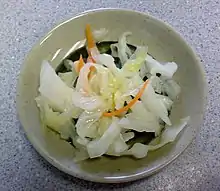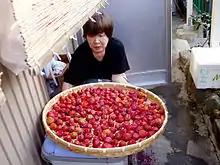Tsukemono
Tsukemono (漬物, literally "pickled things") are Japanese preserved vegetables (usually pickled in salt, brine,[1] or a bed of rice bran).[2] They are served with rice as an okazu (side dish), with drinks as an otsumami (snack), as an accompaniment to or garnish for meals, and as a course in the kaiseki portion of a Japanese tea ceremony.




Alternate names
Tsukemono are also referred to as konomono (香の物), oshinko (御新香) or okōkō (御香々), all carrying the meaning of "fragrant dish" in Japanese.[2] The ko or kō (香) portion in these names literally means "fragrant", and the term was used as a nyōbō kotoba or "woman's word" for miso in reference to the smell. Over time, this term was also applied to pickles, again for the smell. Oshinko (literally "new fragrance" in reference to relative freshness) more specifically referred to vegetables that had been only lightly pickled and that had not yet changed color that much. The term is now also used more broadly to refer to pickles in general.
Making tsukemono
.jpg.webp)
To make tsukemono, one needs a container, salt, and something to apply downward pressure on top of the pickles.[2]
A tsukemonoki (漬物器) (literally "pickling container") is a Japanese pickle press. The pressure is generated by heavy stones called tsukemono ishi (漬物石) (literally "pickle stone") with a weight of one to two kilograms, sometimes more. This type of pickle press is still in use, and can be made from a variety of materials, such as plastic, wood, glass or ceramic. Before tsukemono ishi came into use, the pressure was applied by driving a wedge between a handle of the container and its lid.[2]
The weights are either stone or metal, with a handle on top and often covered with a layer of food-neutral plastic. Another modern type of pickle press is usually made from plastic, and the necessary pressure is generated by turning a screw and clamping down onto the pickles.[2]
Asazuke is a pickling method characterized by its short preparation time.
| Type | Kanji | Pickling Ingredient |
|---|---|---|
| Shiozuke | 塩漬け | salt |
| Suzuke | 酢漬け | vinegar |
| Amasuzuke | 甘酢漬け | sugar and vinegar |
| Misozuke | 味噌漬け | miso |
| Shoyuzuke | 醤油漬け | soy sauce |
| Kasuzuke | 粕漬け | sake kasu (sake lees) |
| Kojizuke | 麹漬け | mold-cultured rice |
| Nukazuke | 糠漬け | rice bran |
| Karashizuke | からし漬け | hot mustard |
| Satozuke | 砂糖漬け | sugar |
Tsukemono types


Takuan (daikon), umeboshi (ume plum), turnip, cucumber, and Chinese cabbage are among the favorites to be eaten with rice as an accompaniment to a meal.
Beni shōga (red ginger pickled in umeboshi brine) is used as a garnish on okonomiyaki, takoyaki and yakisoba.
Gari (thinly sliced young ginger that has been marinated in a solution of sugar and vinegar) is used between dishes of sushi to cleanse the palate.
Rakkyōzuke (a type of onion) is often served with Japanese curry. Rakkyōzuke has a very mild and "fresh" taste. It is pickled and used to balance the stronger flavors of some other component in a meal.
Fukujinzuke is a mixture of daikon, eggplant, lotus root and cucumber which is pickled and flavored with soy sauce.
Bettarazuke is a kind of pickled daikon popular in Tokyo.
Matsumaezuke is a pickled dish (native to Matsumae, Hokkaidō) made from surume (dried squid), konbu, kazunoko (herring roe), carrot and ginger with a mixture of sake, soy sauce and mirin.
Nozawana is a pickled leaf vegetable typical of Nagano Prefecture.
Tsukemono tariffs
According to EU and US trade code definitions, tsukemono are classified as 'preserved vegetables' rather than 'pickles' because they are not primarily preserved in acetic acid or distilled vinegar. They have a different tax rate than western pickles.
See also
- List of Japanese cooking utensils – Wikipedia list article
- Menma – Japanese condiment made from fermented bamboo shoots
- List of pickled foods – List of links to Wikipedia articles on pickled foods
- Takuan – A pickled preparation of daikon radish
- Jangajji – Type of Korean non-fermented pickled vegetable side dish
References
- Reid, Libby (August 2008). TSUKEMONO: A Look at Japanese Pickling Techniques (PDF). Kanagawa International Foundation. p. 4. Archived from the original on 2010-11-24.CS1 maint: bot: original URL status unknown (link)
- Hisamatsu, Ikuko (2013). Tsukemono Japanese Pickling Recipes. Japan: Japan Publications Trading Co., LTD. and Boutique-sha, Inc. p. 6. ISBN 978-4-88996-181-2.
External links
| Wikimedia Commons has media related to Tsukemono. |
- Japanese Food / Tsukemono (pickles)
- Shizuoka Tsukemono Federation
- All JAPAN Pickled Cooperative Association Tsukemono portal site, Typical Tsukemono
